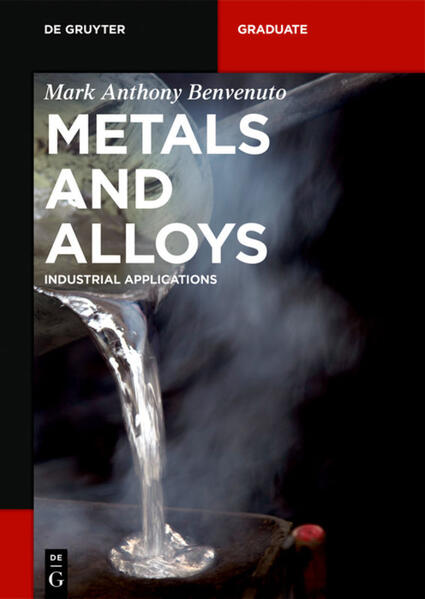
Zustellung: Di, 05.11. - Do, 07.11.
Versand in 2 Tagen
VersandkostenfreiBestellen & in Filiale abholen:
Metals and Alloys
continues the series of graduate textbooks on Industrial Chemistry by Mark A. Benvenuto. It shows the essential industrial applications, processes and chemistry background for the extraction of metals, as well as the production and applications of alloys. The book discusses how large scale and minor processes affect every-day life, challenges in prevention and removal of waste by-products and illustrates selected chemical processes for which efforts have been made to improve and green industrial production of metals and alloys.
Sources for metals are sorted by metal and alloy and backed by basic chemical background information and process set up. Overviews on worldwide ore distribution, refined metal and alloy production numbers are another focus of the book.
- Discusses sources, key processes and applications.
- Connects what students learn in class to real, large-scale metals chemistry that makes modern life possible.
- Intended for students, graduate students and beginners in the fiield of Chemistry, Chemical Process Engineering, Chemical Engineering and Materials Science.
Visit degruyter.com for more information on books by Mark A. Benvenuto: Industrial Chemistry (2013),
Industrial Chemistry: For Advanced Students
(2015) and
Industrial Inorganic Chemistry
(2015).
About the Author:
Mark Anthony Benvenuto
A Fellow of the American Chemical Society, he received his PhD in inorganic chemistry from the University of Virginia. After a post-doctoral fellowship at the Pennsylvania State University, he joined the University of Detroit Mercy, where he is now the Department Chairman and teaches an industrial chemistry course.
Inhaltsverzeichnis
1 Introduction and Overview1.1 Historic, ancient1.2 Large-scale use1.3 18th-19th century discovery1.4 Modern, niche uses 2 Copper 2.1 Bronze2.2 Brass 3 Tin 3.1 Solder3.2 Plating3.3 Niobium-tin 4 Zinc 4.1 Nickel-silver4.2 Solders4.3 Galvanizing4.4 Paint pigments 5 Pewter 5.1 History and traditional uses5.2 Modern applications 6 Gold 6.1 18, 14, 12, 10 carat6.2 White gold6.3 Investment coins6.4 Electronics 7 Silver 7.1 Jewelry7.2 Bullion coinage7.3 Photography 8 Iron 8.1 Pig iron8.2 Steel8.3 Stainless steel8.4 High strength alloys8.5 Wootz steel8.6 Damascus steel 9 Platinum group metals 9.1 Ru 9.2 Os 9.3 Rh 9.4 Ir 9.5 Pd 9.6 Pt 10 Nickel 10.1 Steels 10.2 Super-alloys10.3 Plating 11 Aluminum 11.1 Hall-Heroult Process11.2 Aluminum metal uses11.3 Alloys 12 Titanium 12.1 Titanium refining12.2 Pigment uses12.3 Alloys 13 Magnesium 13.1 Magnesium refining13.2 Mg-Al alloys13.3 Castings and other products 14 Uranium and thorium 14.1 U and Th refining14.2 Uses 15 Americium 15.1 Smoke detectors 16 Mercury 16.1 Chlor-alkali process16.2 Barometers16.3 Thermometers 17 Lanthanides 17.1 Magnets17.2 Sensors 18 Lead 18.1 Batteries18.2 Ammunition, hunting, military18.3 Alloys 19 Tungsten 19.1 Metal refining19.2 Carbide parts19.3 Heavy alloys 20 Tantalum and niobium 21 Sodium 21.1 Reactor moderator21.2 NaK alloys 22 Lithium 22.1 Lightweight alloys22.2 Batteries 23 Solders 23.1 Traditional solder23.2 Low melting alloys 24 Semi-conductors 24.1 Metals required24.2 Metalloids24.3 Doping Index
Mehr aus dieser Reihe
Produktdetails
Erscheinungsdatum
06. Juni 2016
Sprache
englisch
Seitenanzahl
166
Reihe
De Gruyter Textbook
Autor/Autorin
Mark Anthony Benvenuto
Verlag/Hersteller
Produktart
kartoniert
Gewicht
294 g
Größe (L/B/H)
240/170/10 mm
Sonstiges
Paperback
ISBN
9783110407846
Entdecken Sie mehr
Pressestimmen
"[...] graduate students in materials science as well as first year chemical students are likely to find this book worth reading. I recommend this book for people who want to have a rapid overview of metals or for teachers who want to prepare an introduction to metallurgy."
Dominique Daloz in: Journal of Applied Crystallography 2018 (51)
Bewertungen
0 Bewertungen
Es wurden noch keine Bewertungen abgegeben. Schreiben Sie die erste Bewertung zu "Metals and Alloys" und helfen Sie damit anderen bei der Kaufentscheidung.


































